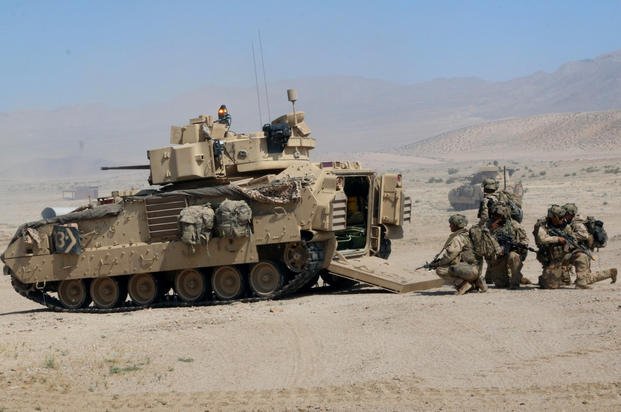After the Army's 1st Infantry Division recently completed a first-ever division-size rotation to the National Training Center, the head of Training and Doctrine Command wants to see other divisions get the same experience.
"Frankly, I think we ought to have one a year just to learn," Gen. Paul E. Funk II told an audience at the Army's 2020 Fires Conference on Tuesday. "What the 1st infantry Division is learning, just through some observations, is going to be invaluable to us."
Read Next: Congress Wants a 'Manhattan Project' for Military Artificial Intelligence
NTC is located at Fort Irwin, California, in the harsh Mojave Desert. Army brigade combat teams typically conduct three-week rotations to pit their combat prowess against the 11th Armored Cavalry Regiment, which acts as the opposing force at the combat training center.
Last year, Army leaders placed a greater emphasis on sending more brigade combat teams to decisive-action rotations at NTC to prepare units to face potential near-peer adversaries such as Russia or China on a future battlefield.
During rotations, brigade and battalion headquarters elements are forced to repeatedly relocate the tents, generators and communications towers that make up their tactical operations centers based on enemy activity, a practice to which the 1st ID's larger headquarters element had to quickly adapt, said Funk, who recently visited NTC to observe the rotation.
"Sometimes, you've just got to put that stuff out in the field in a harsh, harsh, harsh environment to learn whether we've got the ergonomics right, so we understand how to lift and carry this stuff," he said.
The division-sized deployment has provided observations, but it will take other, similar-sized rotations to draw any meaningful conclusions, Funk said.
"They have been one time, by one set of leaders," he explained. "I think once we have had a history of demonstrating these kinds of capabilities, then we have lessons learned."
There was one early conclusion: "Heat, dust, unyielding terrain and temperature affect the division headquarters as much as they do the platoon headquarters," Funk said. "I think the division teams learning to live in harsh environments in expeditionary ... situations is incredibly important."
-- Matthew Cox can be reached at matthew.cox@military.com.
Related: Headed to the Army's National Training Center? Here's What You Need to Know












